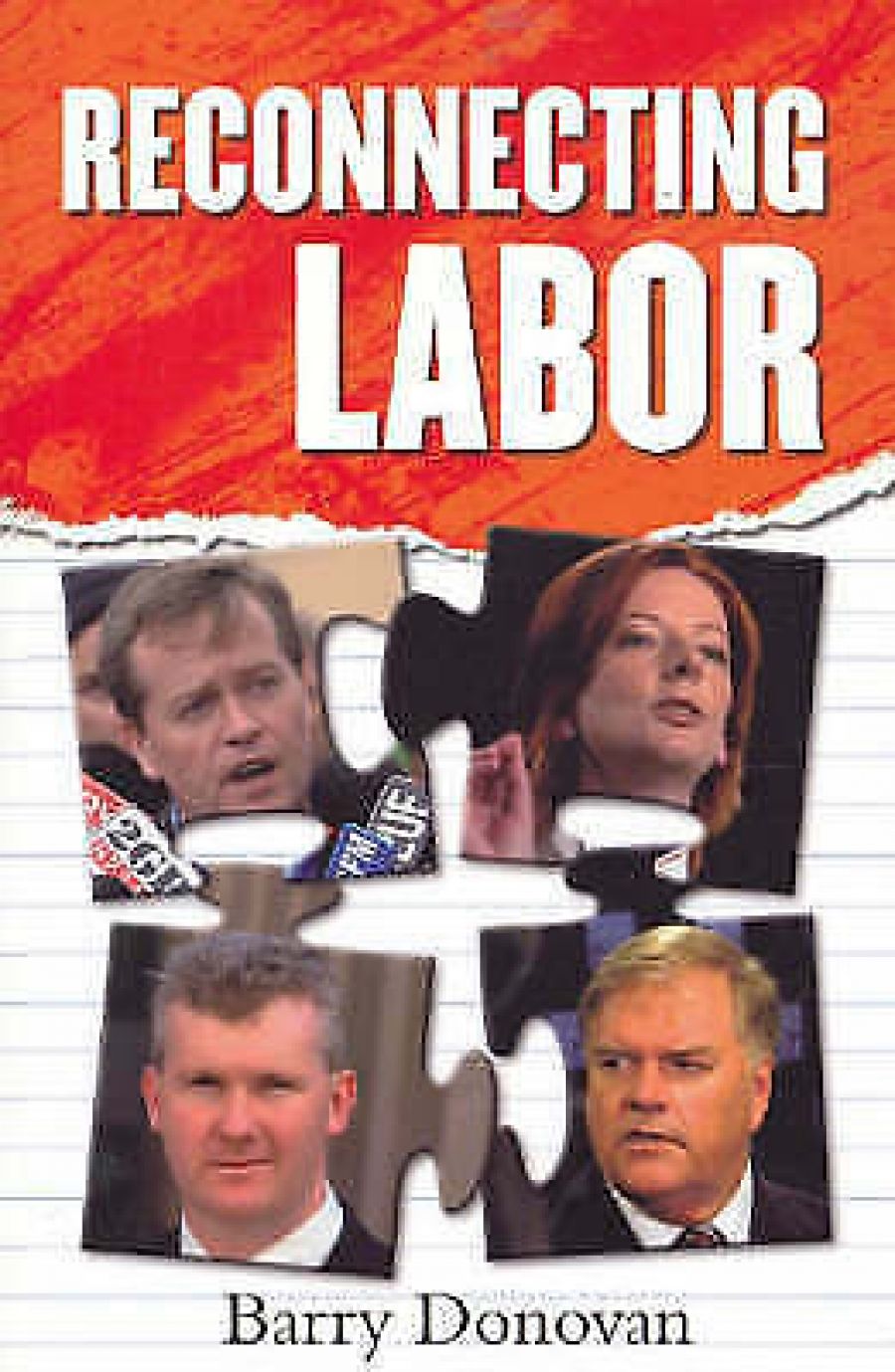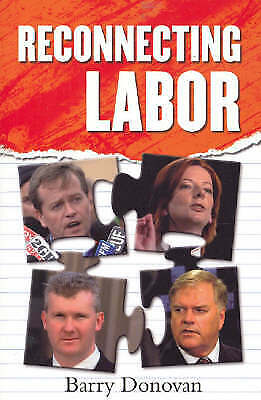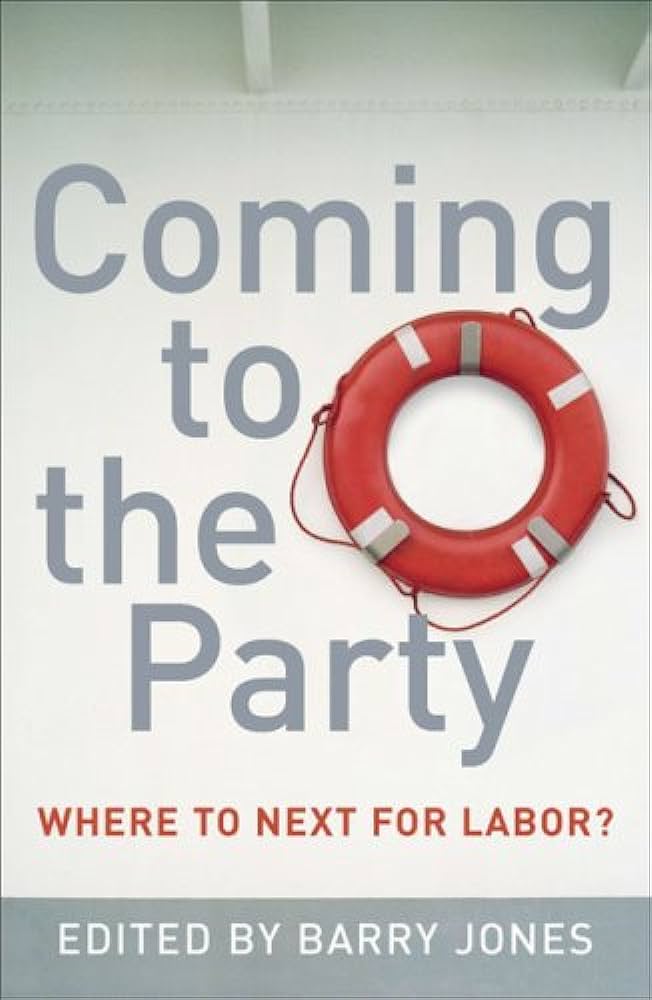
- Free Article: No
- Contents Category: Politics
- Review Article: Yes
- Article Title: Labor’s cottage industry
- Online Only: No
- Custom Highlight Text:
The Liberal Party, in its barren years (1983–96), was consumed in battles over beliefs. The dries took up the cudgels in a war over the nature of liberalism and effectively gained control of the party room. As Paul Kelly has described it, the party torched its Deakinite heritage. John Howard was not central to these battles, but he was the inheritor. His brilliance has been to take the neo-liberal agenda (individualism, choice, markets versus ‘bureaucracy’, the ‘mainstream’ versus ‘élites’), to give it an Australian resonance (by reinterpreting the ‘Australian legend’ as a story of individual battlers) and, relentlessly, to link his profession of beliefs to every policy statement he makes. It is unlikely that most of the punters systematically assess what Howard says in their own voting deliberations, or could complete a test on Howard’s key principles, but impressions have their effects. Recently, when I asked a group whether they thought there was a difference between the parties, a young woman confidently replied: ‘Yes, one party knows what it thinks and gets on with it; the other doesn’t.’
- Book 1 Title: Reconnecting Labor
- Book 1 Biblio: Scribe, $30 pb, 213 pp
- Book 1 Cover Small (400 x 600):

- Book 1 Cover (800 x 1200):

- Book 2 Title: Coming to the Party
- Book 2 Subtitle: Where to next for Labor?
- Book 2 Biblio: MUP, $24.95 pb, 237 pp
- Book 2 Cover Small (400 x 600):

- Book 2 Cover (800 x 1200):

The Labor Party, in its barren years, has generated a cottage industry of analysis of its problems – these books being the latest manifestation. They are as useful as any in depicting the state of play in the party. They are good in identifying the problems of Howard’s rule and in giving voice to the moral indignation this engenders (see chapters in the Jones collection by Carmen Lawrence or John Langmore), depressingly acute in showing the problems within the ALP (Jones, Lawrence, John Faulkner, Rodney Cavalier and John Button), but less compelling in telling us what is to be done. And what they reveal is that there has been no debate within the ALP about beliefs to correspond with the Liberals’ 1980s reinvention: there is little here about what a modern social democratic party should stand for, no answer to Howard’s capture of the ideological agenda. Instead, as both books show in great detail, the party has been consumed in battles between factions – factions now concerned entirely with patronage and the division of spoils, rather than with principles.
Contributors are well aware that Howard’s ‘framing’ of policy debate is their major problem, and references to George Lakoff’s explanation of ‘framing’ as a way of forcing opponents to fight on your ground are plentiful (Lakoff, Don’t Think of an Elephant, 2004). Yet, rather than attempt to formulate a social democratic philosophy for today, and despite Lakoff’s own demonstration of ‘how to take back public discourse’, we get a series of normative prescriptions: Labor should reassure the community about its economic credentials, re-engineer the health system, reinvest in public education, address the widening divide between rich and poor, make the case for active government. This is fine, so far as it goes, but does not provide the link so crucial to Howard’s message: that there is a bedrock of principle underlying each initiative.
If one doesn’t accept the Howard principle, where is one to turn? Surely the essence of social democracy (and the answer to Howard’s vehement individualism) is the belief that individuals cannot truly prosper unless collective well-being is assured? This does not need to be couched as workers versus bosses, rich versus poor, private versus public, but as a proposition that, unless communal goods can be addressed, individual potentials will be squandered. Indeed, more limited assertions, that Labor stands for ‘working people and working families’ – see Bill Shorten or Lindsay Tanner, in Jones – invite a ‘class-war’ riposte, when a creative adaptation of social democracy, as benefiting the whole community, could counter Howard’s claim to speak ‘for all of us’. A capacity to articulate contemporary social democracy and to show how it effects every policy position will be the only way to counter Howard’s success.
What is striking about both of these books is that we get a series of individual voices – there are common themes, but little collective vision. Earlier instances of Labor rejuvenation (the Labor Essays series of the 1970s, for instance) featured policy specialists talking at length about their topic, but in terms of a shared project. And Labor policy generation, in the 1970s and 1980s, was characterised by teamwork (especially under Bill Hayden, but even when driven by strong leadership, such as Gough Whitlam’s).
In these books, each speaks for him/herself, each speaks generally on a range of topics, most with no depth on any of them. It reads as if a range of talented individuals was set a series of problems, and each was asked for their own take: a scattering of views, a skim across broad issues does not persuade us that real, collective policy work is underway. It reminds us that most approaches to trying to rethink the Labor position of recent years have come not from the party proper but from individuals writing books (Mark Latham, Tanner, Duncan Kerr, more recently Craig Emerson and Wayne Swan), as if each had to work things out for himself: a strange outcome in a party ostensibly committed to the collective resolution of social problems.
What is particularly disappointing is the thinness, the ‘doorstep’ mode of taking on big issues, of the much-vaunted coming leaders, Julia Gillard and Shorten. Even Tanner, the man designated as policy coordinator, in an intelligent chapter on turning the attack on the coalition, and ‘rebuilding our brand’, talks of the importance of ‘recent blueprints on skills, infrastructure and energy’ without hinting at their policy content, and without suggesting that anything links these other than his signposts: ‘caring, investing, learning.’ Why could Howard not make an equal claim on any of these words?
Each of these books mixes the views of ‘old’ Labor figures, ‘new’ thinkers and the party hopefuls – and indeed, key figures (Cavalier, Gillard, Shorten and Evan Thornley) feature in both. The distinction is that Jones’s book is a collection of essays; Donovan’s a mix of interviews, excerpts (some of them replicated in Jones’s book) and commentary. I was more engaged with direct access to the voices in the Jones collection: Donovan’s commentary rarely added much, and his authorial interpositions in the interviews simply broke the flow.
What is most valuable in these books is the forceful exposition of why we should care about what Howard is doing to the country (Lawrence, Faulkner, Langmore, and Susan Ryan, in Jones), and the clear identification of the damage that factional dominance and the narrowing occupational base of the political class is doing to the ALP (Jones, Cavalier, Faulkner, Lawrence, Button – but see, too, Tony Burke’s response, in Donovan, to the critics of the ‘professionalisation’ of political careers).
Langmore’s fine, strategic chapter, in Coming to the Party, identifying the challenges facing Labor, what should be done about each of them and how this could translate into policy generation, is exactly the sort of roadmap required, but there is little evidence in the chapters of the parliamentary insiders that they heed his message. The contributions by Joshua Funder (in Jones) and by Thornley (in both books), insist on the importance of investing in ideas, and both speak persuasively of the need to deploy new technologies and new networks to engage new constituencies and to reach directly into the community without the mediation of communications professionals, the channelling of the factions or the distortions of ‘spin’. Yet no one has noticed the lead suggested by Gordon Brown, in a paper to the British cabinet, that it may be time to reconceive progressive parties as network parties, mobilising a congeries of social movements for common purposes, rather than as mass-member parties.
Only Donovan directly addresses the problem of leadership, in his disquisitions on Bob Hawke, Latham and, at State level, Clare Martin and Steve Bracks. He does his best to renovate Kim Beazley, and offers the pragmatism of Martin and Bracks as a sort of model. He does not (and nor does Faulkner, who was much closer to the action) draw the lesson that the Latham débâcle suggests: for all that effective leadership influences voting, to gamble all on the leader is to invite disaster unless the leader is constrained to work with a team and through effective organisational practices.
In a party as dysfunctional (see Button) or as given to ruthless ‘corporate’ models (see Lawrence) as we see Labor to be here, confidence that good leadership will be encouraged is hard to engender. You cannot rely on good leadership unless there are good institutional constraints and a common project informed by a shared vision. Latham invented his own, driven by caprice, at great cost. Beazley might be improving in his delivery of what Tanner calls policy blueprints, but there is no indication yet of a social democratic vision that would link them, and it is hard to assess them as the product of a unified team. Meanwhile, Howard runs the tightest, most disciplined, and (the Costello problem notwithstanding) the most collectively oriented cabinet team we have seen in decades – could the lesson be more obvious?
The ALP can wait for Howard to lose, or it can try to gain control of the agenda. To do the latter requires four things: a clear picture of how things are now; a vision of how they can be improved; a feasible map of how to get there; and a leadership team that instils confidence in the journey. These books are very good on the first of these points, and individual contributors (Ryan, Langmore, Funder, Thornley) take us some way on the second. But I don’t see the map, and I’m not persuaded of the leadership team.
These writers could do worse than to read Billy Hughes’s The Case for Labor (1910) or the famous debate at Centenary Hall, Sydney, between George Reid (Free Trade) and William Holman (Labor) in 1906 for stunning examples of the passionate linkage of contemporary problems with economic debates of the day and a clear formulation of a social democratic project. Of course, their solutions are not ours – it was one hundred years ago – and how social democratic principles should be translated into policy today is a new challenge. But why does that facility escape us now? As E.M. Forster said, ‘Only connect!’


Comments powered by CComment